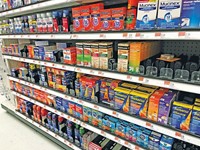Advertisement
Grab your lab coat. Let's get started
Welcome!
Welcome!
Create an account below to get 6 C&EN articles per month, receive newsletters and more - all free.
It seems this is your first time logging in online. Please enter the following information to continue.
As an ACS member you automatically get access to this site. All we need is few more details to create your reading experience.
Not you? Sign in with a different account.
Not you? Sign in with a different account.
ERROR 1
ERROR 1
ERROR 2
ERROR 2
ERROR 2
ERROR 2
ERROR 2
Password and Confirm password must match.
If you have an ACS member number, please enter it here so we can link this account to your membership. (optional)
ERROR 2
ACS values your privacy. By submitting your information, you are gaining access to C&EN and subscribing to our weekly newsletter. We use the information you provide to make your reading experience better, and we will never sell your data to third party members.
Pharmaceuticals
Formulations For Fighting Abuse
Opioid makers aim to thwart misuse with excipients, additives, and antagonists
by Bethany Halford
June 9, 2008
| A version of this story appeared in
Volume 86, Issue 23
IN 1898, chemists at Bayer believed they had a wonder drug on their hands. Their newest pain reliever and cough remedy, a diacetylated form of morphine, was more potent than its parent opioid with one-tenth of its toxic effects. And unlike morphine, this compound wasn't habit-forming, or so proclaimed one report in the Boston Medical & Surgical Journal. The wonder drug's reputation so impressed the members of the St. James Society that the U.S. philanthropic organization began a campaign to mail free samples of the stuff to morphine addicts who were trying to kick the habit.
That wonder drug was heroin. It didn't take long to discover that heroin tablets could be crushed and snorted or dissolved and injected to deliver a tremendous high.
A century later, opioid makers still struggle with the compounds' potential for abuse. These drugs bring relief to millions of people who suffer from chronic pain—one in 10 American adults have experienced pain that lasted for more than a year, according to the National Center for Health Statistics. But the euphoria that opioids induce also makes them susceptible to abuse. In 2006, more than 12 million Americans used prescription pain relievers for nonmedical purposes, according to the most recent National Survey on Drug Use & Health.
In light of the multi-billion-dollar market for pain relievers, pharmaceutical makers have been racing to create abuse-deterrent formulations of opioids, an effort that's been spurred on by the Food & Drug Administration. Last month, a panel of the agency's scientific advisers met to evaluate one such drug, Purdue Pharma's reformulated version of OxyContin.
Introduced in 1995, OxyContin is a controlled-release formulation of oxycodone that provides 12 hours of pain relief. Pain management specialists hailed OxyContin as a breakthrough, and by 2001 it was the most frequently prescribed brand-name narcotic for treating moderate-to-severe pain in the U.S., bringing in more than $1 billion in annual sales.
At the same time, reports were surfacing about the drug's potential for abuse. Crushing, chewing, or dissolving the tablets destroys the controlled-release feature, delivering the entire dose of oxycodone at once and a heroin-like high along with it. Last year, Purdue and three of its executives pleaded guilty to misleading regulators, doctors, and patients about OxyContin's addictive properties and potential for abuse. They agreed to pay $634.5 million in fines.
The reformulated version of OxyContin that Purdue presented to the FDA panel last month has features designed to deter tampering with the tablets. According to Purdue, the pills' formulation makes them more resistant to mechanical forces, such as crushing and chewing, as well as extraction. In the presence of water, an unnamed excipient forms a goo that's hard to draw up into a syringe.
FDA'S EXPERT advisers, however, were apprehensive about the new formulation, citing "poor scientific rigor" in Purdue's data. They weren't convinced that the new formulation would be effective in the real world, and they felt that indicating the tablets were somehow tamper-resistant might give doctors and patients the impression that the drugs aren't abusable or don't carry risks of addiction or overdose.
"The first thing that one needs to realize is that the problem of prescription opioid abuse takes a number of very different forms, each of which would look different from the point of view of a formulation chemist," says Nathaniel Katz, director of the Program on Opioid Risk Management at Tufts Health Care Institute, who frequently consults for pharmaceutical companies developing abuse-deterrent formulations of opioids. "Some pieces of these problems may be addressable with formulation and some may not."
Katz points out that there's never been a systematic study to determine the causes behind fatal overdoses of prescription opioids. Although tampering with tablets and then snorting or injecting them may be behind some deaths, he says, it's also likely that many overdoses occur when people who are not tolerant to opioids swallow large doses of the drugs. Tamper-resistant pills won't solve that problem.
Regardless, Katz says, prescription opioid abuse "is an enormous public health problem," and abuse-deterrent drugs have the potential to help curb it. Despite Purdue's setback with the FDA advisory panel, Katz believes the agency is still eager to bring effective abuse-deterrent formulations to the market.
That's good news for the handful of companies that are pursuing such drugs. "We are working hard to come up with a new kind of medicine that addresses this very important public health concern," says Eric Carter, chief science officer at King Pharmaceuticals. "Opioids are a good medicine when used appropriately."
In partnership with Pain Therapeutics, King has been developing Remoxy, its own long-acting formulation of oxycodone that's physically resistant to crushing and dissolving. Remoxy is a sustained-release gel cap; its oxycodone is suspended in a viscous matrix based on sucrose acetate isobutyrate, an emulsifier used in processed foods.
Crushing Remoxy yields only a thick gel and won't disrupt the chemical matrix that releases the drug slowly, Carter says. King hopes to file a New Drug Application (NDA) for Remoxy within the next few months.
King is also working on a short-acting, abuse-deterrent formulation of oxycodone called Acurox. Carter notes that while abuse of long-acting drugs, such as OxyContin, have gotten a lot of attention in the press, the larger public health concern is with abuse of short-acting formulations, due to the sheer number of prescriptions that are written for these medications.
Acurox, which King is developing with Acura Pharmaceuticals, contains a sub-therapeutic amount of niacin. Take the medicine as prescribed and you'll never notice the niacin, but in high doses the additive brings on unpleasant sensations of flushing, itching, redness, and gastrointestinal discomfort. "What this technology attempts to do is discourage overuse of opioids," Carter explains. "You can't just keep popping these tablets because the niacin makes you uncomfortable."
Acurox is also formulated to irritate nasal passages if snorted, Carter says. And it contains an excipient that creates a gelatinous mass if it comes in contact with water, making it difficult to inject. King anticipates filing an NDA for Acurox by the end of the year.
Scientists at Elite Pharmaceuticals are taking a different approach with their long-acting pain killer, ELI-216. A 24-hour extended-release formulation, ELI-216 comes as a capsule filled with tiny white beads. "Physically the beads look identical," explains Chris Dick, Elite's executive vice president of corporate development, but some contain oxycodone and some contain naltrexone—an antagonist used to treat opioid dependence.
A porous coating encapsulates the oxycodone and a nonporous polymer covers the naltrexone. The porous coating dissolves away in the digestive tract, slowly releasing the oxycodone. Digestive juices can't get through nonporous coating around the naltrexone, so it never enters the system if taken orally.
Crushing or chewing the beads releases the naltrexone, which in turn blocks any euphoric effects from the oxycodone. In a study, recreational drug users reported that consuming crushed ELI-216 gave them virtually no high. Elite is preparing to take the drug into Phase III clinical trials later this year.
Alpharma has used a similar tactic with its long-acting morphine formulation called Embeda. Embeda has a pellet core of naltrexone that passes through the gastrointestinal tract intact. Crushing, chewing, or dissolving the pill releases the euphoria-curbing naltrexone. Alpharma submitted an NDA for Embeda in February but withdrew the application in April. The firm says it plans to resubmit the NDA shortly and is hoping to launch Embeda in the first quarter of 2009.
FDA says it will consider letting drugmakers add language to the labels of these pain relievers that highlights their abuse-deterrent features, but long-term epidemiological studies are necessary to determine if any of these drugs truly curb abuse. "There is no such thing as an absolute abuse-proof formulation," warns Stuart Apfel, chief scientific officer at Elite. "The goal of our formulation and everybody else's formulations is to make it so much more difficult to abuse that the recreational user will find it inconvenient enough not to abuse."
"Formulation is just a part of making opioids safer," Tufts's Katz points out. Doctors also need to prescribe opioids safely, he says, by screening for patients and households at risk for drug abuse. Ultimately, Katz says, "the only thing that's going to solve the prescription opioid abuse problem is to develop analgesics that are not addictive."






Join the conversation
Contact the reporter
Submit a Letter to the Editor for publication
Engage with us on Twitter